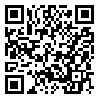Volume 21, Issue 60 (3-2021)
jgs 2021, 21(60): 65-85 |
Back to browse issues page
Download citation:
BibTeX | RIS | EndNote | Medlars | ProCite | Reference Manager | RefWorks
Send citation to:



BibTeX | RIS | EndNote | Medlars | ProCite | Reference Manager | RefWorks
Send citation to:
Mohammadi M. (2021). Physical- skeletal resilience analysis of urban areas based on scenario At the time of the earthquake (Case study: Zanjan city). jgs. 21(60), 65-85. doi:10.52547/jgs.21.60.65
URL: http://jgs.khu.ac.ir/article-1-2931-en.html
URL: http://jgs.khu.ac.ir/article-1-2931-en.html
, m_mohammadi@pnu.ac.ir
Abstract: (17075 Views)
This paper focuses on convergence with the measures and activities of the global assemblies in order to promote the resilience of cities against earthquakes and to pay attention to their physical- skeletal development process, to analyze the resilience of the city of Zanjan and to design scenarios against the earthquake hazard. The criteria used in order of priority and importance include: type of structure, building quality, building life, number of floors, occupancy level, enclosure coefficient, building density, grading, distance from the fault, number of units in the building, user adaptability, slope and facade Building, Which are applied in the three earthquake resilience scenarios after analytical hierarchy analysis (AHP) based on (relation No. 1).
According to the maps drawn from the scenarios, the resiliency rate in the central and southern parts of the city was weak and very weak and as far as we move north, west, and east, we increase the amount of physical resilience of the area. However, no resonance images in the scenario maps show any area with a very resilient domain. As in Ramallah scenarios 7 and 8, the resilience is in a non-resilient and very weak domain. The analysis shows that, according to the maps in any of the areas, there is no stability in the resilience That is, no area in the assessment of all criteria is resilient.
According to the maps drawn from the scenarios, the resiliency rate in the central and southern parts of the city was weak and very weak and as far as we move north, west, and east, we increase the amount of physical resilience of the area. However, no resonance images in the scenario maps show any area with a very resilient domain. As in Ramallah scenarios 7 and 8, the resilience is in a non-resilient and very weak domain. The analysis shows that, according to the maps in any of the areas, there is no stability in the resilience That is, no area in the assessment of all criteria is resilient.
Type of Study: Research |
Subject:
Geography and Urban Planning
Send email to the article author
| Rights and permissions | |
 |
This work is licensed under a Creative Commons Attribution-NonCommercial 4.0 International License. |

This work is licensed under a Creative Commons — Attribution-NonCommercial 4.0 International (CC BY-NC 4.0)







